SUMMARY
This is AI generated summarization, which may have errors. For context, always refer to the full article.
![[Newsstand] The Marcoses’ three-body problem](https://www.rappler.com/tachyon/2024/04/tl-marcoses-3-body-problem.jpg)
The success of the Marcos-Duterte electoral alliance in 2022 was so massive it could be said that the political equivalent of Newton’s law of inertia applied to it. A body moving at constant speed in a straight line will continue moving at constant speed in a straight line unless a force acted upon it. The alliance – if all went well, if the different parts moved at the same speed and kept to the same line – had a lock on the 2028 presidential election, which in our part of the universe determines other political possibilities.
And then a force acted upon it. Now the alliance has descended into a war of the dynasties, between the Marcoses and the Dutertes, and an opening is starting to form, not necessarily for the political opposition but perhaps for a political third force led by someone like the populist, and popular, Senator Raffy Tulfo.
But the reality of politics has always been messy; perhaps Newton’s laws of motion cannot really explain it. For some analysts, the break between the Marcoses and the Dutertes was inevitable; inertia was never an explanation. But some politicians believed in the alliance, and continue to do so even in the middle of the dynastic war; the law of action and reaction governs their pragmatic attempts to end it.
Another way to look at the political situation today, to understand the “chaos” affecting the political class, is to borrow the theory at the heart of the popular Netflix series, 3-Body Problem, based on Cixin Liu’s The Three-Body Problem trilogy.
What is the three-body problem?
The character Wang Miao explains: “It’s actually pretty simple. The reason why the sun’s motion seems patternless is because our world has three suns. Under the influence of their mutually perturbing gravitational attraction, their movements are unpredictable – the three-body problem. When our planet revolves around one of the suns in a stable orbit, that’s a Stable Era. When one or more of the other suns move within a certain distance, their gravitational pull will snatch the planet away from the sun it’s orbiting, causing it to wander unstably through the gravitational fields of the three suns. That’s a Chaotic Era. After an uncertain amount of time, our planet is once again pulled into a temporary orbit and another Stable Era begins. This is a football game at the scale of the universe. The players are the three suns, and our planet is the football.”
(This excerpt is of course from the Ken Liu translation.)
The three suns in the second Marcos administration are President Marcos, his older sister Senator Imee Marcos, and his cousin Speaker Martin Romualdez.
We can measure their gravitational pull on the planet of Philippine politics according to three factors: the scale of rehabilitation of the Marcos legacy and name, the question of presidential succession, and the choice of primary geopolitical partner. There must be other criteria, but I suggest that these three form the core. These describe their hold on their moons, account for the difference in their orbits – and explain why the Stable Era promised by the UniTeam’s unprecedented victory has deteriorated into a Chaotic Era.
Marcos legacy
I think that President Marcos understands his election in 2022 as a completion of the task his family imposed on him since at least 1995, the first time he ran for national office; he has rehabilitated the Marcos name simply by winning the office his father held for 20 years. His election created the minimum condition of rehabilitation – that the public regard his father no longer as a dictator but as “just another” president, the first Marcos – and I think he is happy to claim the win.
Senator Marcos’s definition of rehabilitation is much broader. She wants public opinion to reflect how she thinks of her father, as a great man wronged by history. She wants to restore her father to an imagined gallery of greatness, and this requires nothing less than a repudiation of the Edsa People Power uprising. (On rereading, I see that my July 2022 column “The four REs of the Marcos restoration” actually tracks Imee’s position more closely than her brother’s.) For Imee, it is not enough for the first Marcos to be seen as just another president.
Speaker Romualdez’s idea of rehabilitation is just as expansive, but in a different direction. He expects it to cover not only the Marcoses but the Romualdezes too. For him, the true measure of rehabilitation is if another member of their extended family succeeds his cousin. His reading has disturbed others in the political class, even those who warmly welcomed the return of the Marcoses to Malacañang, because it unnecessarily tests the boundaries of political power. One may be willing to concede power to a family for six years, but 12?
Presidential succession
Marcos continues to keep his personal relationship with his vice president warm, even in the face of outright hostility and insolent language from his predecessor the former president and the two Duterte sons. I think he is pragmatic enough to accept a Duterte as a successor, if that is the way his political interests lie; at the same time, he cannot but be open to a Romualdez or a Tulfo, for the same reason. But it seems clear that his influential wife’s counsel is what he will keep. This sub-factor is a particular sticking point with other members of the political class, especially the Dutertes.
Imee Marcos was one of Rodrigo Duterte’s original supporters in his long-shot campaign for the presidency in 2016, and was instrumental in convincing Duterte’s more popular daughter Sara to run as Bongbong Marcos’s running mate in 2022. As I see it, she wants her family to honor the explicit or implied agreement with the Dutertes that made the UniTeam tandem possible in the first place: Support Sara for president in 2028. While her definition of political rehabilitation is maximalist, her understanding of the dynamic of presidential elections is much more pragmatic. She sees Sara as still the candidate to beat in 2028 AND also the president who can consolidate the gains of the Marcoses best.
From all indications, Speaker Romualdez wants to become the next president. He may still run for a third term as representative of the 1st District of Leyte next year, but his long-term strategy may likely involve a Senate run in 2025. A strong showing would place him in strong contention for 2028. (See Gloria Arroyo in 1995, or Grace Poe in 2013.) The ongoing campaign to raise his profile in different congressional districts is an expensive signal; to give only one example, the constituency-serving facility set up on Kamuning Street in Quezon City, while ostensibly an alliance between the district representative and his wife Yedda Romualdez’s Tingog party-list group, features only one larger-than-life image: his.
Superpower ally
Before Marcos came to power, I thought he would continue moving in the direction set by President Duterte’s pivot to China; his family’s historical ties with Chinese leadership weighed heavily in my estimate. Instead, he has firmly redirected Philippine foreign policy back to Washington DC and the Western alliance. This must stem in part from the recognition that there is an international aspect to the project of rehabilitation; in his view, the course of cleaning up the family name runs through key Western capitals.
Senator Marcos would favor a return to the Duterte China-first policy. The language she used in presenting her seven-point plan in September 2022 as Senate foreign affairs committee chair speaks of “engagement” with Beijing, but her remarks since then suggest collaboration rather than engagement, to the extent that today she is seen as the principal non-Duterte defender of China. (She resents this perception.)
Romualdez has controversially accompanied the President on many of his foreign travels, in part to assert his idea of “legislative diplomacy” and his ideal of Congress as a full partner of the Executive in foreign policy. But he shares the pro-Western view of his cousin, Ambassador to the United States Babe Romualdez; donated $2 million to fund a Tagalog course in Harvard University; has consistently supported the strengthening of Philippine-American ties. As president, he would likely deepen the Philippine partnership with the United States.
Chaotic era
In the last two years, the three suns have each increased in mass. Romualdez’s Lakas-CMD is now the largest single party in Congress, and he has proved that he can make Congress jump through hoops. Imee has reinforced her ties with the Dutertes, who have been welcoming former allies (such as former Speaker Pantaleon Alvarez) back into the fold; at the same time, she has leaned into her role as a dependable source, “good copy,” for the media. The President remains buoyed both by constant travel and the warm welcome of Western allies; the scope of influence of his wife Lisa Araneta Marcos has also widened.
As a result, their “mutually perturbing gravitational attraction ” has also grown. The turmoil within the ruling coalition includes many celestial anomalies: a stealthy two-pronged campaign to change the Constitution; open conflict between the Senate and the House; a tightening of the net around key Duterte allies; the suddenly more substantial shadow of the International Criminal Court looming from The Hague; even more aggressive interventions by Beijing in the West Philippine Sea; ever closer ties with Washington, Tokyo, Canberra, London.
All this instability can be explained simply. There are three competing centers of gravity within the extended Marcos family. – Rappler.com
Veteran journalist John Nery is a Rappler columnist, editorial consultant, and program host. His In the Public Square streams on Rappler platforms every Wednesday at 8 pm.
1 comment
How does this make you feel?



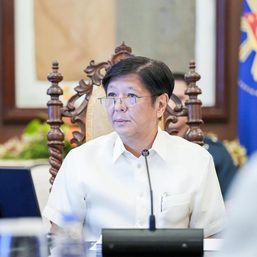
![[WATCH] #TheLeaderIWant: Filipino voters sound off on community issues a year before 2025 elections](https://www.rappler.com/tachyon/2024/05/filipino-voters-sound-off-on-community-issues-1.jpg?resize=257%2C257&crop=276px%2C0px%2C720px%2C720px)

![[WATCH] In the Public Square with John Nery: The Marcoses’ three-body problem](https://www.rappler.com/tachyon/2024/04/pubsq-sq.jpg?resize=257%2C257&crop=390px%2C0px%2C1080px%2C1080px)
![[EDITORIAL] Kalaban mo ang mga senador na protektor ni Quiboloy](https://www.rappler.com/tachyon/2024/03/animated-quiboloy-kojc-senate-carousel.jpg?resize=257%2C257&crop=365px%2C0px%2C720px%2C720px)
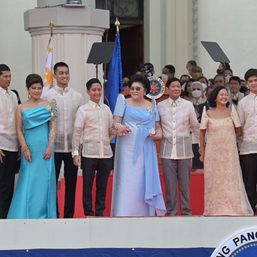

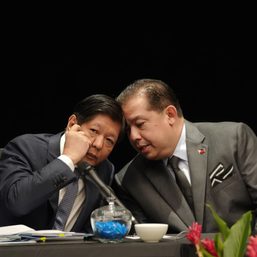
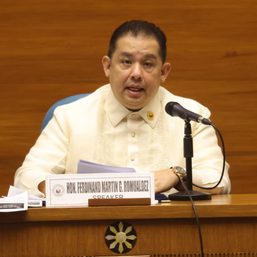

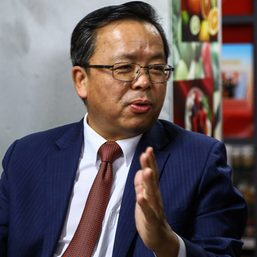
If I could add to the growing “mutually perturbing gravitational attraction” and “many celestial bodies,” how would Digong, Sara Duterte, Quiboloy, Tulfo, USA, and China be represented? Are they moons that are orbiting their corresponding suns? How about the Filipino People? Are they the humankind who will bear what such “chaos” brings?